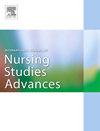探讨虚拟现实技术应用对老年人心理健康的影响:一项综合综述
IF 3.1
Q1 NURSING
International Journal of Nursing Studies Advances
Pub Date : 2025-06-27
DOI:10.1016/j.ijnsa.2025.100371
引用次数: 0
摘要
虚拟现实技术的应用经常被认为是减少老年人心理问题的一种新兴方法,但评估结果并不一致。关于虚拟现实技术对老年人心理健康的延伸影响,特别是对他们潜在心理需求的影响的探索很少。目的通过文献综述,探讨虚拟现实技术对老年人心理健康的影响。本研究采用Whittemore和Knafl的综合评价方法。方法对CINAHL、MEDLINE、ProQuest、Web of Science 4个主要数据库进行检索。纳入的研究是全文,同行评审,英文撰写,发表于2020年1月至2024年10月,涉及针对60岁或以上老年人的基于虚拟现实的主要实验干预,并报告了至少一项或多项心理健康影响。纳入文献13篇,随机对照试验研究6篇,准实验研究7篇,其中定量设计8篇,定性设计2篇,混合方法研究设计3篇。调查共涉及952名参与者。研究环境包括养老院/老年护理机构、大学老年中心、医疗中心和指定的研究地点。采用关键评估技能计划(CASP)检查表来评估研究质量。Ryff的心理健康框架被用作基础思想。结果13篇论文中46% (n=6)发表于2023年和2024年。纳入的研究在不同的地理位置进行,包括中东(n=2, 15.4%)、亚洲(n=5, 38.5%)、欧洲(n=4, 30.8%)、北美(n=1, 7.7%)和澳大利亚(n=1, 7.7%)。虚拟现实干预包括回忆活动、休闲游戏、娱乐和放松体验、治疗性运动、社交虚拟平台和联合治疗干预。最后确定了五个扩展影响。结论虚拟现实技术应用对老年人潜在心理需求的延伸影响和满足,应引起护理专业人员的重视。本文章由计算机程序翻译,如有差异,请以英文原文为准。
Explore the extended impacts on psychological well-being in older adults through application of virtual reality technology: An integrative review
Background
The application of virtual reality technology is often presented as an emergent method to reduce older adults’ mental problems however the results of evaluations remain inconsistent. There has been little exploration of the extended impacts of virtual reality technology on older adults’ psychological well-being and, in particular, on their underlying psychological demands.
Objectives
This study aims to conduct an integrative review of recent literature to explore the extended impacts on the psychological well-being in older adults through application of virtual reality technology.
Design
This study adopted Whittemore and Knafl’s integrative review methodology.
Methods
Four major databases including Cumulative Index to Nursing and Allied Health Literature (CINAHL) Complete, Medical Literature Analysis and Retrieval System Online (MEDLINE), ProQuest, and Web of Science were searched. The included studies were in full text, peer reviewed, English written, published from January 2020 to October 2024, involved a primary experimental virtual reality-based intervention for older adults aged 60 or above, and reported at least one or more psychological well-being impacts. Among the 13 included literature, 6 were randomized controlled trial studies and 7 were quasi-experimental studies, of which, 8 used quantitative design, 2 used qualitative design and 3 used mixed-methods research design. A total of 952 participants were involved. The research settings included nursing homes/elderly care facilities, university aging centre, medical centre, and designated research site. Critical Appraisal Skills Programme (CASP) Checklists were adapted and employed to appraise the study quality. Ryff’s framework of Psychological Well-Being was used as the underpinning idea.
Results
Among the 13 articles, 46% (n=6) were published in 2023 and 2024. The included studies were conducted in diverse geographical locations including the Middle East (n=2, 15.4%), Asia (n=5, 38.5%), Europe (n=4, 30.8%), North America (n=1, 7.7%), and Australia (n=1, 7.7%). The virtual reality interventions included reminiscence activities, recreation gaming, entertainment and relaxation experiences, therapeutic exercise, social virtual platforms and combined therapy intervention. Five extended impacts were identified finally.
Conclusions
Through this review, we highlight nurse professionals should take note of the extended impacts and the fulfilment on older adults’ underlying psychological demands through application of virtual reality technology.
求助全文
通过发布文献求助,成功后即可免费获取论文全文。
去求助
来源期刊

International Journal of Nursing Studies Advances
Nursing-General Nursing
CiteScore
5.80
自引率
0.00%
发文量
45
审稿时长
81 days
 求助内容:
求助内容: 应助结果提醒方式:
应助结果提醒方式:


